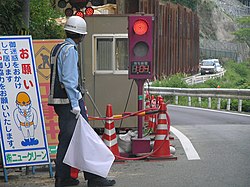Traffic guard
Appearance
(Redirected from Traffic Guard)
 Japanese traffic guard | |
| Occupation | |
|---|---|
| Names | Flagger, Traffic Controller |
Occupation type | Employment |
Activity sectors | Traffic, law enforcement, security, civil engineering |
| Description | |
Related jobs | Construction worker, guard, police |


Traffic guards, also known as traffic controllers and flaggers, are trained to set up warning signs and barricades to slow down the speed of traffic in a temporary traffic control zone. When they are on scene they will set up equipment to warn approaching traffic about the incident.[1]
Equipment
[edit]Traffic guards use a variety of equipment:[1]
- Signal flags.
- Signal hand sign; called stop/slow paddles in the United States, these are a sign that has 'stop' on one side and 'slow' or 'go' on the other side.
- Traffic vest.
- Helmet (or a hard hat); protecting the head from hazards.
Automated traffic controls
[edit]In some cases, alternatives to human traffic guards are used for traffic control. Traffic guards may be assisted by Automated flagger assistance devices (AFADs) so that they can stay out of the roadway when directing traffic.[2] Temporary traffic lights or yield signs may also be used as an alternative to human traffic guards.[3]
See also
[edit]- Traffic police
- State police
- Security police
- Security guard
- Parking enforcement officer
- Highway patrol
- Crossing guard
- Level crossing
- Road traffic control
- Road traffic safety
- Roadworks
- Traffic barrier
- Traffic cadet
References
[edit]- ^ a b "Traffic Controllers (Flagger)". ny.gov. New York State DOT. Retrieved 20 September 2021.
- ^ Finley, Melisa D (January 1, 2013). "Field Evaluation of Automated Flagger Assistance Devices in Work Zones on Two-Lane Roads". Transportation Research Record: Journal of the Transportation Research Board. 2337 (1): 1–8. doi:10.3141/2337-01. S2CID 109343882. Retrieved 20 September 2021.
- ^ Ullman, G L; Levine, S Z; Booker, S C (April 1987). "Flagger safety and alternatives to manual flagging". Transportation Research Record: Journal of the Transportation Research Board (406–1F): 56. Retrieved 20 September 2021.
